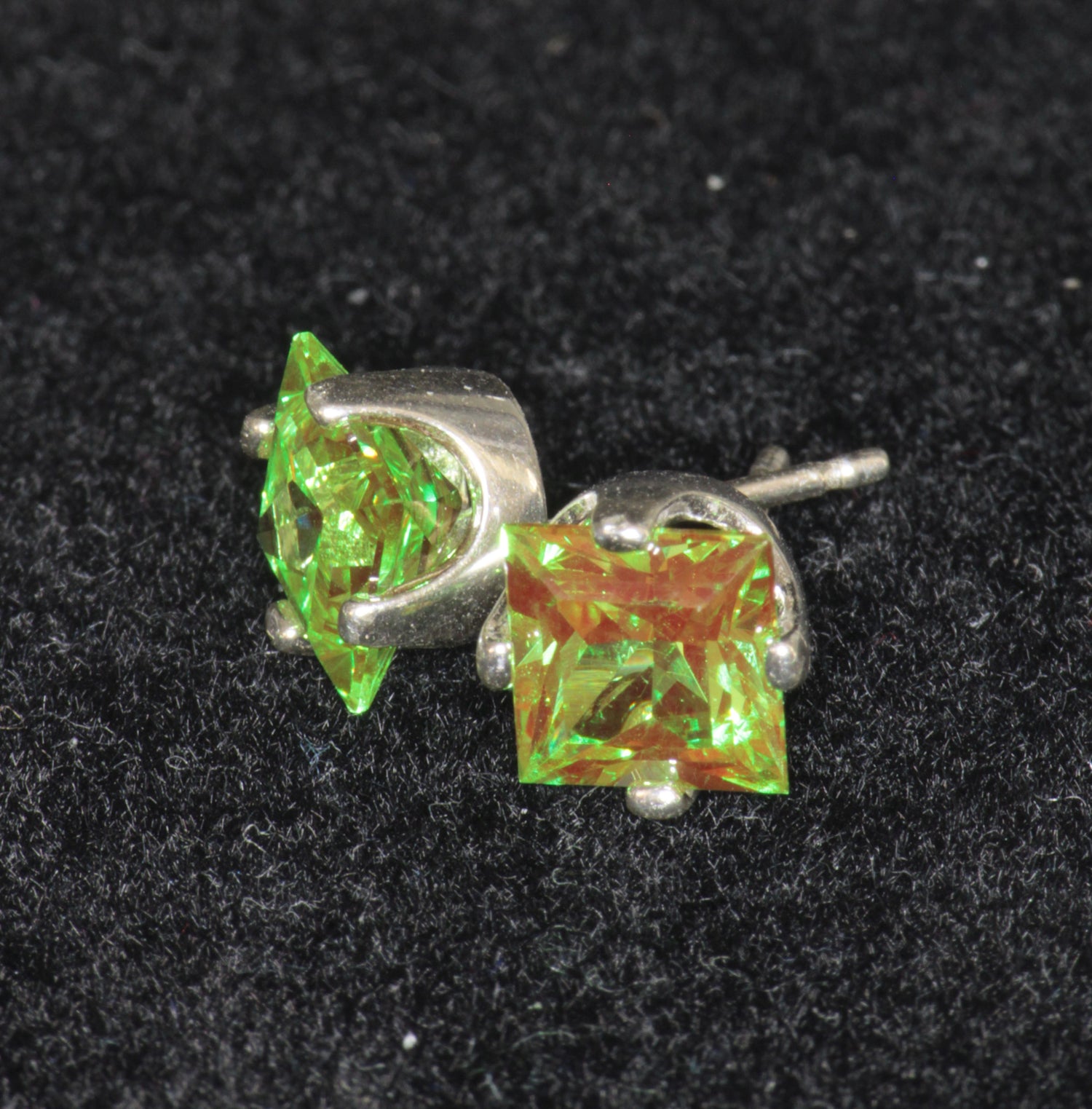Properties of Labmade Stones
Labmade stones can have extremely unusual properties in all sorts of magnetic, electrical, acoustic, and other ways, but for gem usage most people just want to know the hardness, density, refractive index, and dispersion. Here's a quick cheat sheet of the properties for our labmade stones.
Collapsible content
Labmade Stone Properties
| Species | Formula | Mohs | Density | RI | Dispersion |
| Alexandrite | Al2BeO4 | 8.5 | 3.72 | 1.75 | 0.015 |
| BGO-12 (White Bismuth Germanate) | Bi4Ge3O12 | 4.5 | 7.13 | 2.09 | 0.102 |
| BGO-20 (Orange Bismuth Germanate) | Bi12GeO20 | 4.5 | 9.22 | 2.57 | 0.221 |
| Fluorite | CaF2 | 4 (with cleavage planes) | 3.18 | 1.4 | 0.007 (lowest!) |
| GAGG (Gadolinium Aluminum Gallium Garnet) | Roughly Gd3Al2Ga3O12 | 8 | 6.6 | 1.9 | ~0.033 |
| GGG (Gadolinium Gallium Garnet) | Gd5Ga3O12 | 6.5-7.5 | 7.08 | 1.97 | 0.045 |
| LaB6 (Lanthanum Hexaboride) | LaB6 | 8 - 9 (?) | 4.72 | opaque | opaque, >2 |
| Lithium Niobate | LiNbO3 | 5 | 4.65 | 2.3 | 0.125 |
| Lithium Tantalate | LiTaO3 | 5.75 | 7.45 | 2.18 | 0.075 |
| LuAG (Lutetium Aluminum Garnet) | Lu3Al5O12 | 8.5 | 6.7 | 1.9 | 0.025 |
| LYSO (Lutetium-Yttrium Oxyorthosilicate) | Between Lu2SiO5 and Y2SiO5 | 5.8 | 4.4 (YSO) to 7.4 (LSO) | ~1.8 | ~0.03 |
| Moissanite | SiC | 9.25 | 3.22 | 2.65 | 0.104 |
| Rutile | TiO2 | 6.5 | 4.25 | 2.61 | up to 0.330! |
| Sapphire/Ruby | Al2O3 | 9 | 3.98 | 1.76 | 0.018 |
| Spinel | MgAl2O4 | 7.5 - 8.0 | 3.6 | 1.71 | 0.026 |
| Strontium Titanate | SrTiO3 | 5.5 | 5.1 | 2.4 | 0.19 |
| TGG (Terbium Gallium Garnet) | Tb3Ga5O12 | 8 | 7.13 | 1.95 | ~0.045 |
| Wakefieldite (Yttrium Orthovanadate) | YVO4 | 5 (with cleavage planes) | 4.24 | 2.1 | 0.084 |
| YAG (Yttrium Aluminum Garnet) | Y3Al5O12 | 8.5 | 4.5 | 1.8 | 0.028 |
| YAP (Yttrium Aluminum Perovskite) | Y3Al5O12 | 8.6 | 5.5 | 1.95 | 0.031 |
| Zinc Sphalerite | ZnS | 4 | 4.05 | 2.36 | 0.163 |
Overview and Pictures
With that out of the way, here's some other information about our lab-made gems. Most were produced for scientific and industrial purposes.
These include rare crystals that haven’t been seen in the gem trade before, as well as old classics which have been grown with extreme care and purity. Here’s a little info on some of the crystals we have in stock!
Labmade Garnets:

Yttrium-Aluminum Garnet
Ce:YAG
Ce:YAG was developed in the 1970s for use as a 'scintillator' (ie: a crystal that glows when radiation hits it, to make radiation easier to detect). It is the first of what we call 'lumogarnets' - that is, labmade garnets with very noticable fluorescence in normal lighting. Ce:YAG has the purest yellow of the lumogarnets. It glows so bright that the first time I saw one, I scanned it with my Geiger counter just to be sure it wasn't radioactive (it wasn't).

Lutetium Aluminum Garnet
Ce:LuAG
LuAG started production in the late '90s. It has an intense neon-green fluorescence which is incredibly appealing - and, because the human eye is most sensitive to green, it is also the brightest glow we've ever seen. This photo is of the largest known faceted LuAG in the world, cut by our pal Eric at HouseOfSylas. We gave it to the scientists who made it, and it currently lives in the lab where it was grown.

Gadolinium Aluminum Gallium Garnet
Ce:GAGG
The latest generation garnet scintillator, GAGG has an incredibly bright yellow fluorescence (slightly greener than YAG), as well as some phosphorescence - it will glow in the dark! While all pieces have at least a bit of afterglow, a few rare 'high-glow' pieces will glow for hours. We call the best of the best 'Firefly Garnet'.
GAGG is also paramagnetic, so you can pick it up with a rare earth magnet! It's super cool!
We even have pixels which almost made it into machines!

Yttrium Aluminum Garnet with Chromium
Christmas Garnets
One of the most unusual gems, Christmas garnet is both red and green - the green is the base color of the crystal, while the red comes from the strong fluorescence. It's not a traditional color change, but it can look very different depending on lighting and background - greener on white surfaces, redder on black ones.
Moissanite (Silicon Carbide)
Moissanite (SiC) has been mass produced for industry as an abrasive since the late 1800s (known as "carborundum"), but it is only in the last few decades that it became possible to grow large crystals, and even later than that where it became useful as a gem.
Halfway between a pure silicon crystal and a pure diamond, silicon carbide computer chips are used instead of silicon chips in areas where structural strength and heat resistance matter - today, over 50% of cars use silicon carbide chips.

Dichroic Moissanite
Under normal circumstances, Moissanite must be grown in an argon atmosphere, because the growing crystals will suck nitrogen out of the air. When crystals are inadvertently exposed, they can end up with this dichroic blue/yellow color scheme, showing blue dowm two axes of the crystal, and yellow down the third.

Black Moissanite
So dark that it is opaque, black moissanite has an incredible luster, making it great for cabochons and larger dark gems.

Smoky Moissanite
Although smoky moissanite has a very similar tint and color to smoky quartz, it has a much higher dispersion, making cut stones much more lively. Much like smoky quartz, it often can be found with fine needle inclusions.
